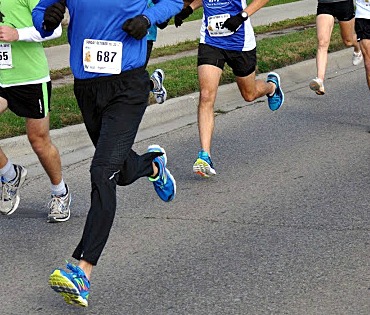A study by Robbins and Waked put the materials used in traditional running shoes advertised as ‘state of the art’ with ‘advanced shoe technology’ to the test and found that these advertising messages were deceptive.
The researchers found that impact was greatest in shod conditions advertised as having advanced shoe technology (i.e. more cushioned material) compared to the barefoot condition. And with each subsequent trial, footfall impact significantly increased in the shod condition!

Barefoot Reduces Forceful Interactions with the Ground
To prevent high impact footfalls, barefoot runners naturally adjust knee and hip flexion (bending of these joints) whereby higher knee and hip flexion reduces more impact.
Therefore, the greater the knee and hip flexion when running, the lighter the footfall, the softer the ground feels under the bare foot.
In contrast, when knee and hip flexion is reduced during running, footfall impact is amplified.
Cushioned running shoes interfere with the body’s natural ability to adjust hip and knee flexion. As a result, the runner changes their landing tactics by landing harder. The body’s attempts to naturally modify knee and hip flexion, a reflexive-action evolved by humans millions of years ago, becomes impaired in the traditional running shoe.
Similarly, gymnast were found to land with more impact on soft, thick cushioned mats, but landed with significantly more stability and with less impact on harder surfaces! Why? Because harder surfaces are more stable and are a direct route to allow the body to reflexively increase hip and knee flexion.
The same scenario occurs in runners who run in excessively cushioned running shoes -the cushioning destabilizes the body-ground interaction. Form this, the researchers concluded that humans land more rigidly on soft, unnatural materials such as EVA foam, gel pads, etc. as a protective strategy to counter the instability given off by the plushness of the soft material.
Although it may seem counterintuitive, the less cushioning under your feet, the better your body will be at deflecting impact which decreases your chances of getting injured.
More From Run Forefoot:
- Examples of Forefoot Running Shoes
- Top 5 Vibram Five Fingers
- More on the Dangers of Cushioned Shoes
- Why Running Fast is Better than Running Slow
References:
McNitt-Gray JL, Yokoi T. The influence of surface characteristics on the impulse characteristics of drop landings. Proceedings of the 13′ Annual Meeting of the American Society of Biomechanics. Vermont: American Society of Biomechanics, 1989: 92-3.
Robbins SE and Waked E. Hazard of deceptive advertising on athletic footwear. Br J Sports Med, 1997; 31:299-303.
Robbins S, Waked EG. Humans amplify impact to compensate for instability caused by shoe sole materials. Arch PhysMed Rehabil 1997;78:463-7.
Bretta Riches
BSc Neurobiology; MSc Biomechanics candidate, ultra minimalist runner & founder of RunForefoot. I was a heel striker, always injured. I was inspired by the great Tirunesh Dibaba to try forefoot running. Now, I'm injury free. This is why I launched Run Forefoot, to advocate the health & performance benefits of forefoot running and to raise awareness on the dangers of heel striking, because the world needs to know.
Latest posts by Bretta Riches (see all)
- Does Foot Strike Really Matter in Running? YES! - 17/04/2024
- Heel Lifts Increase Injury in Runners - 16/04/2024
- Are Minimalist Shoes Good for Seniors? YES! - 14/04/2024

We have actually utilized over 80 Buy SoundCloud.
as well as giving your organisation a good increase.